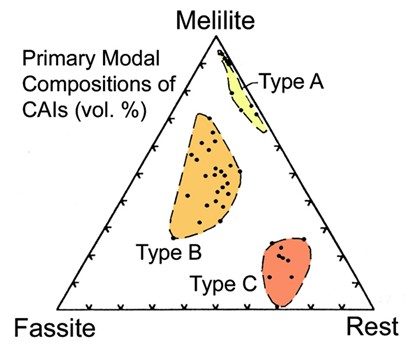Calcium Aluminum-rich Inclusion

Sub-millimeter to centimeter-sized amorphousMaterial without the regular, ordered structure of crystalline solids. Amorphous substances, like glass, lack a definite repeating pattern in their atomic structures (crystallinity). There may be small regions of order, but, overall there is disorder. Click on Term to Read More objects found typically in carbonaceous chondritesChondrites are the most common meteorites accounting for ~84% of falls. Chondrites are comprised mostly of Fe- and Mg-bearing silicate minerals (found in both chondrules and fine grained matrix), reduced Fe/Ni metal (found in various states like large blebs, small grains and/or even chondrule rims), and various refractory inclusions (such Click on Term to Read More and ranging in color from white to greyish white and even light pink. CAIs have occasionally been found in ordinary chondrites, such as the L3.00 chondriteChondrites are the most common meteorites accounting for ~84% of falls. Chondrites are comprised mostly of Fe- and Mg-bearing silicate minerals (found in both chondrules and fine grained matrix), reduced Fe/Ni metal (found in various states like large blebs, small grains and/or even chondrule rims), and various refractory inclusions (such Click on Term to Read More, NWA 8276 (Sara Russell, 2016). CAIs are also known as refractory inclusionsInclusions found predominantly in carbonaceous chondrites and are rich in refractory elements particularly calcium, aluminum and titanium that in various combinations form minerals such as spinel, melilite, perovskite and hibonite. There are two types of refractory inclusion: • Ca Al-rich inclusions (CAIs) • Amoeboid olivine aggregates (AOAs) Refractory inclusions were Click on Term to Read More since they are comprised of high-temperature refractory minerals, including silicates and oxides of Ca, Al, and Ti. In 2002, an international team of scientists accurately dated CAIs at 4.567 Ga, making them the oldest (earliest formed) known objects in the solar systemThe Sun and set of objects orbiting around it including planets and their moons and rings, asteroids, comets, and meteoroids.. The same team found that chondrulesRoughly spherical aggregate of coarse crystals formed from the rapid cooling and solidification of a melt at ~1400 ° C. Large numbers of chondrules are found in all chondrites except for the CI group of carbonaceous chondrites. Chondrules are typically 0.5-2 mm in diameter and are usually composed of olivine Click on Term to Read More, another of the earliest relics of the solar systemDefinable part of the universe that can be open, closed, or isolated. An open system exchanges both matter and energy with its surroundings. A closed system can only exchange energy with its surroundings; it has walls through which heat can pass. An isolated system cannot exchange energy or matter with, formed 2-3 Ma after CAIs. Both types of object formed when dusty regions of the solar nebulaThe primitive gas and dust cloud around the Sun from which planetary materials formed. experienced transient heating events of, at present, an unknown origin. The dust melted and then crystallized, forming first CAIs and during later event(s), chondrules.
“CAIs formed by evaporationProcess in which atoms or molecules in a liquid state (or solid state if the substance sublimes) gain sufficient energy to enter the gaseous state. Click on Term to Read More, condensation, and aggregation in a gas of approximately solar composition in a hot (ambient temperature >1300 K) disk region exposed to irradiation by solar energetic particles, probably near the protoSun. Subsequently, some CAIs were melted in and outside their formation region during transient heating events of still unknown nature.”1
There are three types of CAIs:
- Type A CAIs are melilite-rich, fine-grained and irregularly shaped. There are also type A CAIs called fluffy CAI.
- Type B CAIs are coarse-grained, consisting of Al-Ti-pyroxene (fassiteObsolete name for Ca- and Ti-rich clinopyroxene, properly termed augite. Click on Term to Read More), meliliteGroup of minerals found in the CAIs of meteorites such as CV chondrites. Melilite consists almost exclusively of the binary solid solution gehlenite (Ca2Al2SiO7) – åkermanite (Ca2MgSi2O7). The melilite in CAIs is closer to gehlenite in composition. The first-formed (highest-temperature) melilite crystallizing from a melt is relatively aluminum-rich and becomes progressively Click on Term to Read More, anorthiteRare compositional variety of plagioclase and the calcium end-member of the plagioclase feldspar mineral series with the formula CaAl2Si2O8. Anorthite is found in mafic igneous rocks such as anorthosite. Anorthite is abundant on the Moon and in lunar meteorites. However, anorthite is very rare on Earth since it weathers rapidly Click on Term to Read More and spinelMg-Al oxide, MgAl2O4, found in CAIs..
- Type C CAIs are anorthite-rich and coarse-grained.

Some or all content above used with permission from J. H. Wittke.






